Vegetation Restoration Outpaces Climate Change in Driving Evapotranspiration in the Wuding River Basin
Abstract
1. Introduction
2. Study Region and Data
2.1. Study Region
2.2. Datasets
2.2.1. Data Source
2.2.2. Data Processing
3. Methods
3.1. The PT-JPL Model
3.2. Indicators Used in the Verification of PT-JPL Model Results
3.3. Trend Analysis
3.4. Partial Correlation
3.5. Attribution Analysis
3.6. The Driving Factors of ET
3.7. Path Analysis
4. Results
4.1. Validation of ET Simulation
4.2. Spatiotemporal Patterns of ET
4.2.1. Interannual Trends of ET
4.2.2. Multi-Year Mean Spatial Distribution Patterns of ET
4.2.3. Spatial Distribution, Temporal Trends, and Significance of ET Changes
4.3. Temporal–Spatial Characteristics of LAI and Climatic Factors
4.3.1. The Temporal–Spatial Characteristics of LAI and Climatic Factors
4.3.2. Multi-Year Mean Spatial Distribution Patterns of LAI and Climatic Factors
4.3.3. Spatial Trends and Significance of Changes in LAI and Climatic Factors
4.4. Changes in ET Caused by Vegetation Restoration and Climate Change
5. Discussion
5.1. Response Mechanism of ET to Vegetation Change
5.2. Response Mechanism of ET to Climate Change
5.3. Implications for Water Resource Management and Vegetation Restoration
5.4. The Uncertainty and Limitations
6. Conclusions
Author Contributions
Funding
Data Availability Statement
Acknowledgments
Conflicts of Interest
References
- Yang, L.; Feng, Q.; Adamowski, J.F.; Alizadeh, M.R.; Yin, Z.; Wen, X.; Zhu, M. The role of climate change and vegetation greening on the variation of terrestrial evapotranspiration in northwest China’s Qilian Mountains. Sci. Total Environ. 2021, 759, 13. [Google Scholar] [CrossRef] [PubMed]
- Huang, Q.; Zhang, Y.; Li, C.; Ma, N. Quantifying propagation effects of climate and vegetation changes on evapotranspiration and streamflow signatures in Yarlung Tsangpo River Basin. J. Hydrol. Reg. Stud. 2024, 56, 102015. [Google Scholar] [CrossRef]
- Zhao, W.L.; Gentine, P.; Reichstein, M.; Zhang, Y.; Zhou, S.; Wen, Y.; Lin, C.; Li, X.; Qiu, G.Y. Physics-Constrained Machine Learning of Evapotranspiration. Geophys. Res. Lett. 2019, 46, 14496–14507. [Google Scholar] [CrossRef]
- Peng, L.; Zeng, Z.; Wei, Z.; Chen, A.; Wood, E.F.; Sheffield, J. Determinants of the ratio of actual to potential evapotranspiration. Glob. Change Biol. 2019, 25, 1326–1343. [Google Scholar] [CrossRef] [PubMed]
- Li, X.; Pan, Y.; Zhao, C. Main influencing factors of terrestrial evapotranspiration for different land cover types over the Tibetan Plateau in 1982–2014. Front. Environ. Sci. 2024, 12, 1346469. [Google Scholar] [CrossRef]
- Zhang, J.; Zhou, X.; Yang, S.; Ao, Y. Spatiotemporal Variations in Evapotranspiration and Their Driving Factors in Southwest China between 2003 and 2020. Remote Sens. 2023, 15, 4418. [Google Scholar] [CrossRef]
- He, G.; Zhao, Y.; Wang, J.; Gao, X.; He, F.; Li, H.; Zhai, J.; Wang, Q.; Zhu, Y. Attribution analysis based on Budyko hypothesis for land evapotranspiration change in the Loess Plateau, China. J. Arid. Land 2019, 11, 939–953. [Google Scholar] [CrossRef]
- Jin, L.; Chen, S.; Yang, H.; Zhang, C. Evaluation and Drivers of Four Evapotranspiration Products in the Yellow River Basin. Remote Sens. 2024, 16, 1829. [Google Scholar] [CrossRef]
- Yu, K.-X.; Liu, J.; Zhang, X.; Li, P.; Li, Z.; Zhang, X.; Zhao, Y. Evapotranspiration fusion and attribution analysis in the upper and middle reaches of the Yellow River Basin. J. Hydrol. Reg. Stud. 2024, 53, 101773. [Google Scholar] [CrossRef]
- Li, Y.; Liang, K.; Bai, P.; Feng, A.; Liu, L.; Dong, G. The spatiotemporal variation of reference evapotranspiration and the contribution of its climatic factors in the Loess Plateau, China. Environ. Earth Sci. 2016, 75, 354. [Google Scholar] [CrossRef]
- Ma, L.; Yu, G.; Chen, Z.; Yang, M.; Hao, T.; Zhu, X.; Zhang, W.; Lin, Q.; Liu, Z.; Han, L.; et al. Cascade effects of climate and vegetation influencing the spatial variation of evapotranspiration in China. Agric. For. Meteorol. 2024, 344, 109826. [Google Scholar] [CrossRef]
- Jiang, X.; Wang, Y.; Yinglan, A.; Wang, G.; Zhang, X.; Ma, G.; Duan, L.; Liu, K. Optimizing actual evapotranspiration simulation to identify evapotranspiration partitioning variations: A fusion of physical processes and machine learning techniques. Agric. Water Manag. 2024, 295, 108755. [Google Scholar] [CrossRef]
- Ma, N. Modeling land-atmosphere energy and water exchanges in the typical alpine grassland in Tibetan Plateau using Noah-MP. J. Hydrol. Reg. Stud. 2023, 50, 15. [Google Scholar] [CrossRef]
- Wu, J.; Feng, Y.; Zheng, C.; Zeng, Z. Dense flux observations reveal the incapability of evapotranspiration products to capture the heterogeneity of evapotranspiration. J. Hydrol. 2023, 622, 129743. [Google Scholar] [CrossRef]
- Sun, J.-Y.; Sun, X.-Y.; Hu, Z.-Y.; Wang, G.-X. Exploring the influence of environmental factors in partitioning evapotranspiration along an elevation gradient on Mount Gongga, eastern edge of the Qinghai-Tibet Platea, China. J. Mt. Sci. 2020, 17, 384–396. [Google Scholar] [CrossRef]
- Sun, M.; Dong, Q.; Jiao, M.; Zhao, X.; Gao, X.; Wu, P.; Wang, A. Estimation of Actual Evapotranspiration in a Semiarid Region Based on GRACE Gravity Satellite Data—A Case Study in Loess Plateau. Remote Sens. 2018, 10, 2032. [Google Scholar] [CrossRef]
- Huang, T.; Liu, Y.; Wu, Z.; Xiao, P.; Wang, J.; Sun, P. Quantitative analysis of runoff alteration based on the Budyko model with time-varying underlying surface parameters for the Wuding River Basin, Loess Plateau. Ecol. Indic. 2024, 158, 111377. [Google Scholar] [CrossRef]
- Zhang, H.; He, Z.; Xu, J.; Mu, W.; Chen, Y.; Wang, G. Analysis of Spatial and Temporal Changes in Vegetation Cover and Driving Forces in the Wuding River Basin, Loess Plateau. Forests 2024, 15, 82. [Google Scholar] [CrossRef]
- Ma, Y.; Huang, H.Q.; Xu, J.; Brierley, G.J.; Yao, Z. Variability of effective discharge for suspended sediment transport in a large semi-arid river basin. J. Hydrol. 2010, 388, 357–369. [Google Scholar] [CrossRef]
- Zeng, Y.; Yu, Q.; Wang, X.; Ma, J.; Xu, C.; Qiu, S.; Liu, W.; Wang, F. Research on the Relationship between the Structure of Forest and Grass Ecological Spaces and Ecological Service Capacity: A Case Study of the Wuding River Basin. Remote Sens. 2023, 15, 2456. [Google Scholar] [CrossRef]
- Shao, R.; Zhang, B.; Su, T.; Long, B.; Cheng, L.; Xue, Y.; Yang, W. Estimating the Increase in Regional Evaporative Water Consumption as a Result of Vegetation Restoration Over the Loess Plateau, China. J. Geophys. Res. Atmos. 2019, 124, 11783–11802. [Google Scholar] [CrossRef]
- Liu, Y.; Lin, Z.; Wang, Z.; Chen, X.; Han, P.; Wang, B.; Wang, Z.; Wen, Z.; Shi, H.; Zhang, Z.; et al. Discriminating the impacts of vegetation greening and climate change on the changes in evapotranspiration and transpiration fraction over the Yellow River Basin. Sci. Total Environ. 2023, 904, 23. [Google Scholar] [CrossRef] [PubMed]
- Han, P.; Yang, G.; Liu, Y.; Chen, X.; Wen, Z.; Shi, H.; Hu, E.; Xue, T.; Zhao, Y. Vegetation Restoration Enhanced Canopy Interception and Soil Evaporation but Constrained Transpiration in Hekou–Longmen Section During 2000–2018. Agronomy 2024, 14, 2606. [Google Scholar] [CrossRef]
- Hooper, D.; Joseph, C.; Mullen, M.R. Structural Equation Modelling: Guidelines for Determining Model Fit. Electron. J. Bus. Res. Methods 2008, 1, 53–60. [Google Scholar]
- Guo, J.; Fan, L.; Feng, P.; Sun, X.; Xue, S. Response of vegetation evapotranspiration to landscape pattern changes in an arid region: A case study of the Loess Plateau, China. Catena 2025, 252, 108878. [Google Scholar] [CrossRef]
- Wang, F.; Liang, W.; Fu, B.; Jin, Z.; Yan, J.; Zhang, W.; Fu, S.; Yan, N. Changes of cropland evapotranspiration and its driving factors on the loess plateau of China. Sci. Total Environ. 2020, 728, 138582. [Google Scholar] [CrossRef]
- Wang, H.; Lv, X.; Zhang, M. Sensitivity and attribution analysis of vegetation changes on evapotranspiration with the Budyko framework in the Baiyangdian catchment, China. Ecol. Indic. 2021, 120, 9. [Google Scholar] [CrossRef]
- Zhang, B.; Tian, L.; Zhao, X.; Wu, P. Feedbacks between vegetation restoration and local precipitation over the Loess Plateau in China. Sci. China Earth Sci. 2021, 64, 920–931. [Google Scholar] [CrossRef]
- Kong, L.; Zheng, H.; Rao, E.; Xiao, Y.; Ouyang, Z.; Li, C. Evaluating indirect and direct effects of eco-restoration policy on soil conservation service in Yangtze River Basin. Sci. Total Environ. 2018, 631–632, 887–894. [Google Scholar] [CrossRef]
- Lu, F.; Hu, H.; Sun, W.; Zhu, J.; Liu, G.; Zhou, W.; Zhang, Q.; Shi, P.; Liu, X.; Wu, X.; et al. Effects of national ecological restoration projects on carbon sequestration in China from 2001 to 2010. Proc. Natl. Acad. Sci. USA 2018, 115, 4039–4044. [Google Scholar] [CrossRef]
- Sera’ie, F.; Sakti, A.D.; Komara, H.Y.; Sumarga, E.; Choiruddin, A.; Hendrawan, V.S.A.; Hati, T.; Anna, Z.; Wikantika, K. Optimizing afforestation and reforestation strategies to enhance ecosystem services in critically degraded regions. Trees For. People 2024, 18, 100700. [Google Scholar]
- Hu, Z.; Chen, X.; Li, Y.; Zhou, Q.; Yin, G. Temporal and Spatial Variations of Soil Moisture over Xinjiang Based on Multiple GLDAS Datasets. Front. Earth Sci. 2021, 9, 13. [Google Scholar] [CrossRef]
- Lai, X.; You, Y.; Yang, X.; Wang, Z.; Shen, Y. Quantifying the rainfall variability effects on crop growth and production in the intensified annual forage-winter wheat rotation systems in a semiarid region of China. Agric. Water Manag. 2024, 305, 109131. [Google Scholar] [CrossRef]
- Yu, S.; Liu, Z.; Guo, J.; Wang, Y.; Yu, P.; Xu, L.; Wang, Y.; Chao, Y. Distribution of evapotranspiration components along vertical layers and their controls in dry days of larch plantation in the Liupan Mountains of northwest China. Agric. For. Meteorol. 2024, 358, 110265. [Google Scholar] [CrossRef]
- Wei, X.; Zhang, H.; Gong, X.; Wei, X.; Dang, C.; Zhi, T. Intrinsic Cross-Correlation Analysis of Hydro-Meteorological Data in the Loess Plateau, China. Int. J. Environ. Res. Public Health 2020, 17, 2410. [Google Scholar] [CrossRef]
- Ouyang, Z.; Zheng, H.; Xiao, Y.; Polasky, S.; Liu, J.; Xu, W.; Wang, Q.; Zhang, L.; Xiao, Y.; Rao, E.; et al. Improvements in ecosystem services from investments in natural capital. Science 2016, 352, 1455–1459. [Google Scholar] [CrossRef]
- He, Q.; Di, D.; Yang, R.; Yuan, W.; Xiao, J.; Yao, Y.; Chen, Q.; Shi, W. Released control of vapor pressure deficit on rainfed rice evapotranspiration responses to extreme droughts in the subtropical zone. Plant Soil 2024. [Google Scholar] [CrossRef]
- Chattopadhyay, N.; Hulme, M. Evaporation and potential evapotranspiration in India under conditions of recent and future climate change. Agric. For. Meteorol. 1997, 87, 55–73. [Google Scholar] [CrossRef]
- Zhang, J.; Liu, Y.; Hou, F. Changes in vegetation and soil coupling induced by biocrusts: New thinking on the segmented control of soil and water loss in the Loess Plateau, China. Ecol. Indic. 2024, 161, 9. [Google Scholar] [CrossRef]
- Shen, N.; Wang, Z.; Guo, Q.; Zhang, Q.; Wu, B.; Liu, J.; Ma, C.; Delang, C.O.; Zhang, F. Soil detachment capacity by rill flow for five typical loess soils on the Loess Plateau of China. Soil Tillage Res. 2021, 213, 12. [Google Scholar] [CrossRef]
- Sun, S.; Liu, Y.; Chen, H.; Ju, W.; Xu, C.-Y.; Liu, Y.; Zhou, B.; Zhou, Y.; Zhou, Y.; Yu, M. Causes for the increases in both evapotranspiration and water yield over vegetated mainland China during the last two decades. Agric. For. Meteorol. 2022, 324, 19. [Google Scholar] [CrossRef]
- Wu, W.; Nel, W.; Ji, J.; Chen, J. Prospects for the potential carbon sink effects of afforestation to enhance weathering in China. J. Asian Earth Sci. 2024, 276, 7. [Google Scholar] [CrossRef]
- Tian, F.; Lü, Y.H.; Fu, B.J.; Zhang, L.; Zang, C.F.; Yang, Y.H.; Qiu, G.Y. Challenge of vegetation greening on water resources sustainability: Insights from a modeling-based analysis in Northwest China. Hydrol. Process. 2017, 31, 10. [Google Scholar] [CrossRef]
- Jian, S.; Wei, Y.; Wang, P.; Niu, Y.; Yu, X. Soil moisture driven by vegetation restoration on the Chinese Loess Plateau: A synthesis and meta-analysis. Acta Geophys. 2025, 73, 1819–1832. [Google Scholar] [CrossRef]
- Tao, S.; Fang, J.; Ma, S.; Cai, Q.; Xiong, X.; Tian, D.; Zhao, X.; Fang, L.; Zhang, H.; Zhu, J.; et al. Changes in China’s lakes: Climate and human impacts. Natl. Sci. Rev. 2020, 7, 132–140. [Google Scholar] [CrossRef]
- Zhang, L.; Marshall, M.; Nelson, A.; Vrieling, A. A global assessment of PT-JPL soil evaporation in agroecosystems with optical, thermal, and microwave satellite data. Agric. For. Meteorol. 2021, 306, 16. [Google Scholar] [CrossRef]
- Wang, R.; Dong, Z.; Zhou, Z.; Wang, N.; Zhao, H. Effects of phytogenic mound on overland flow pathway, hydraulic characteristics and soil water redistribution at a patch scale in the Loess Plateau of China. Catena 2024, 246, 108430. [Google Scholar] [CrossRef]
- Gao, M.; Wu, Z.; Guo, X.; Yan, D. Emergy evaluation of positive and negative benefits of agricultural water use based on energy analysis of water cycle. Ecol. Indic. 2022, 139, 13. [Google Scholar] [CrossRef]

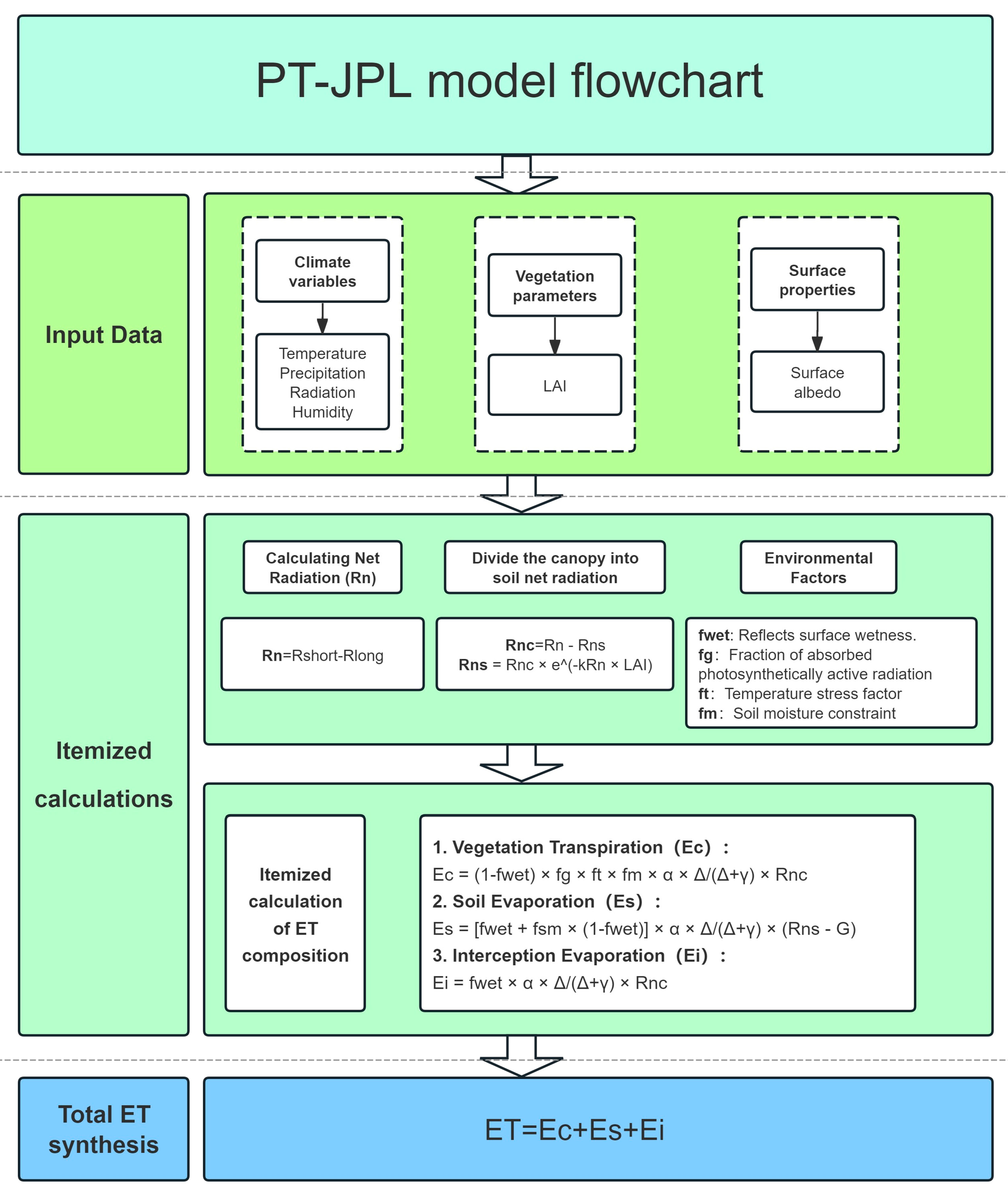
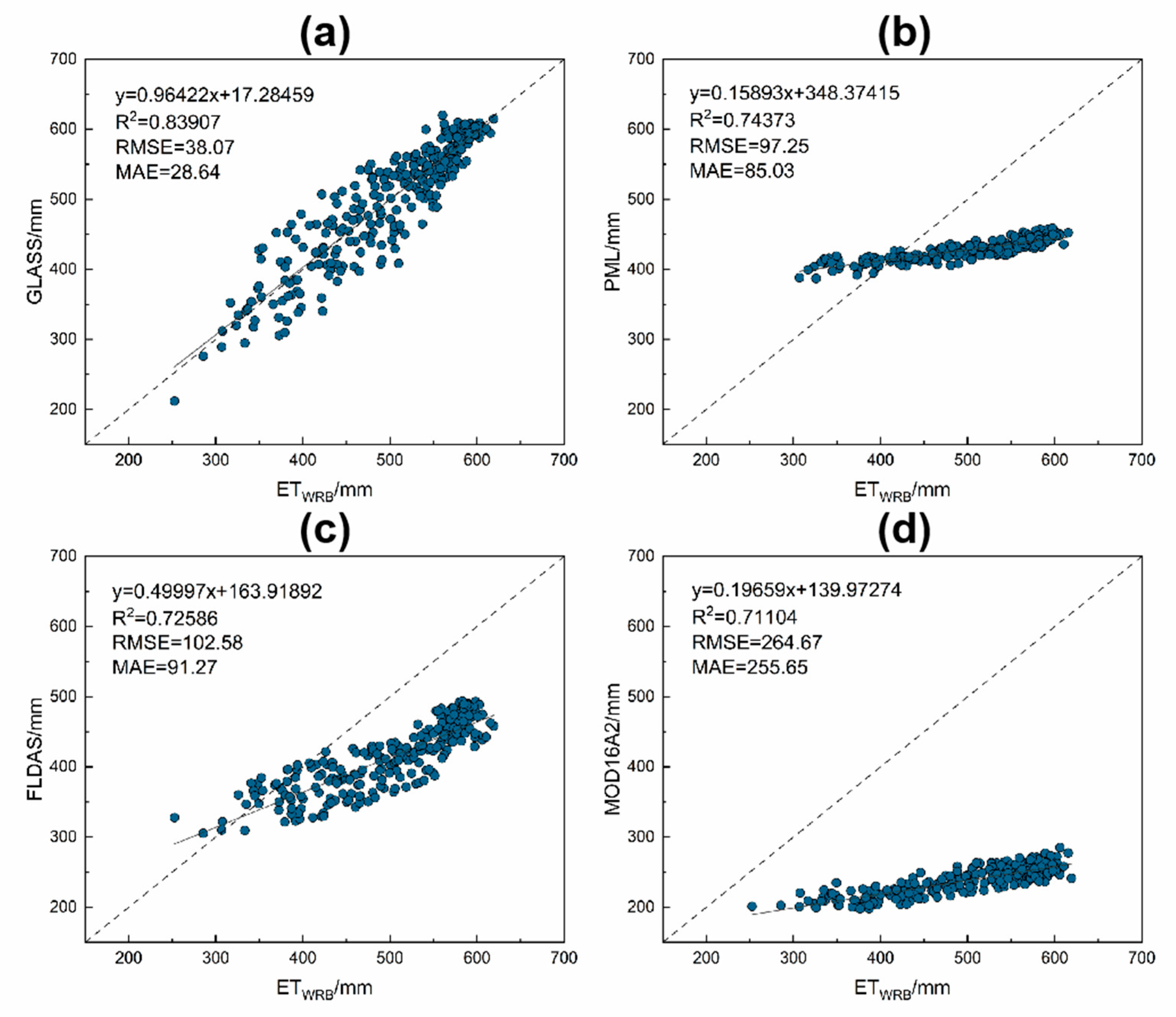
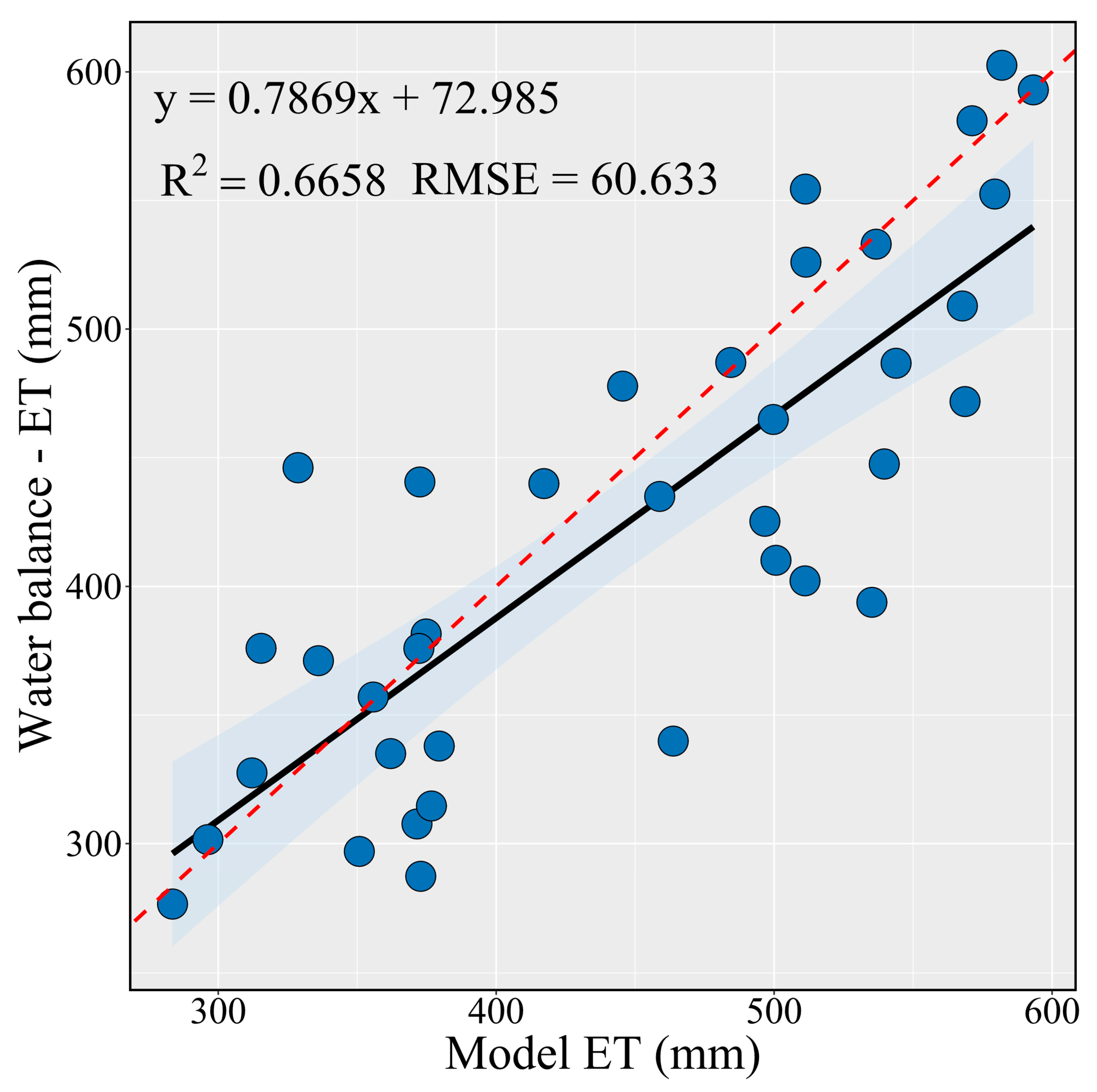
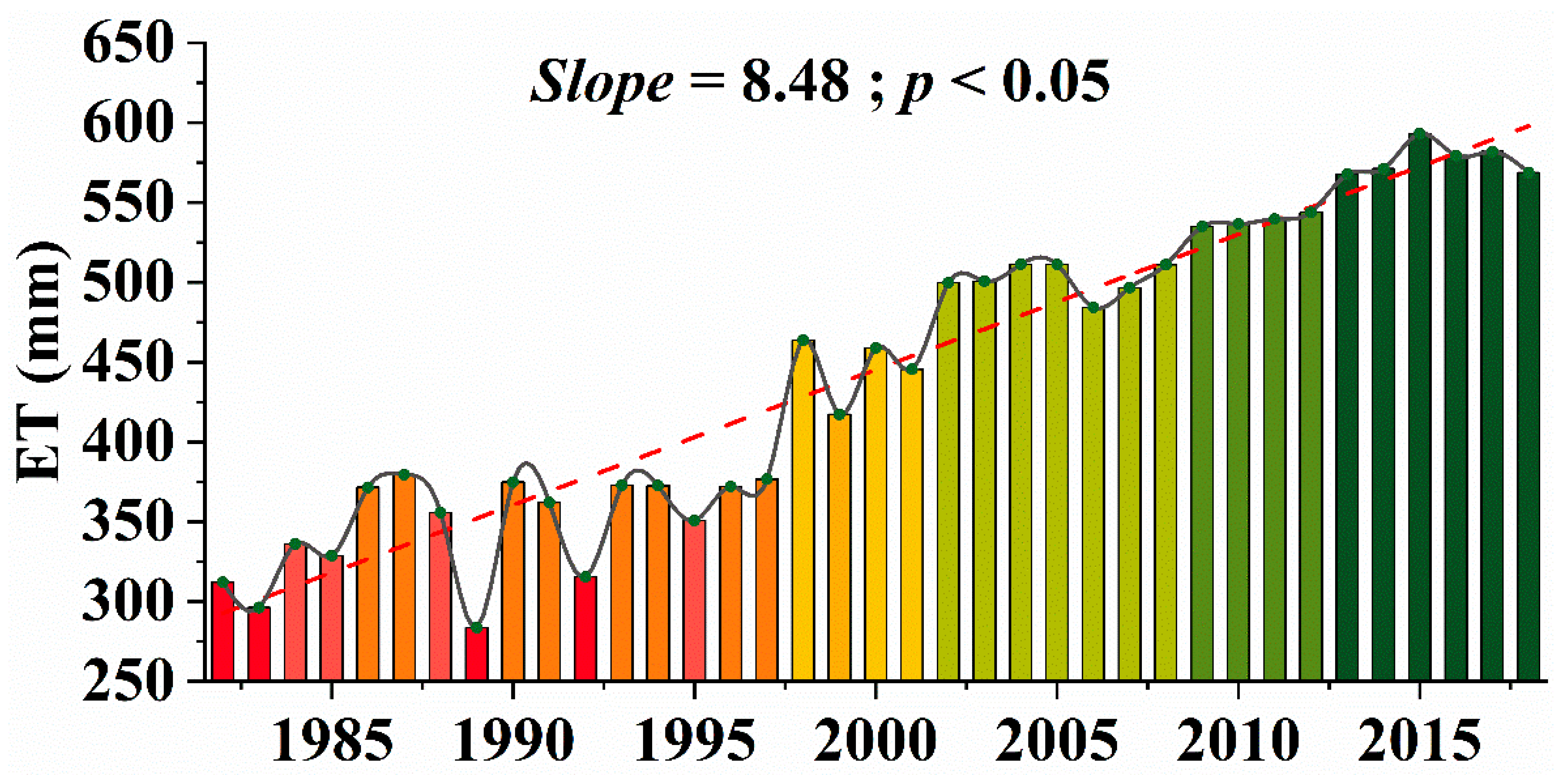


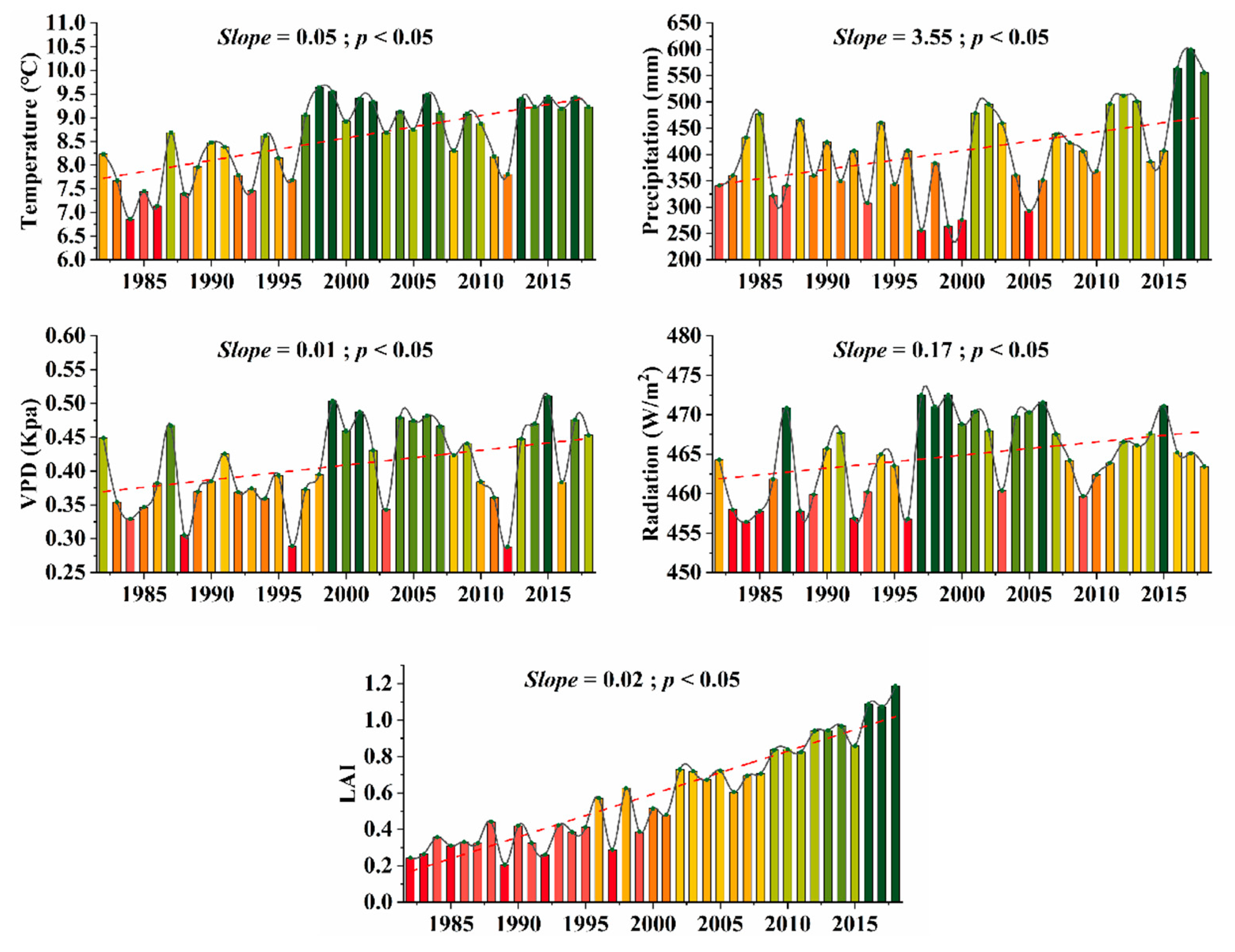
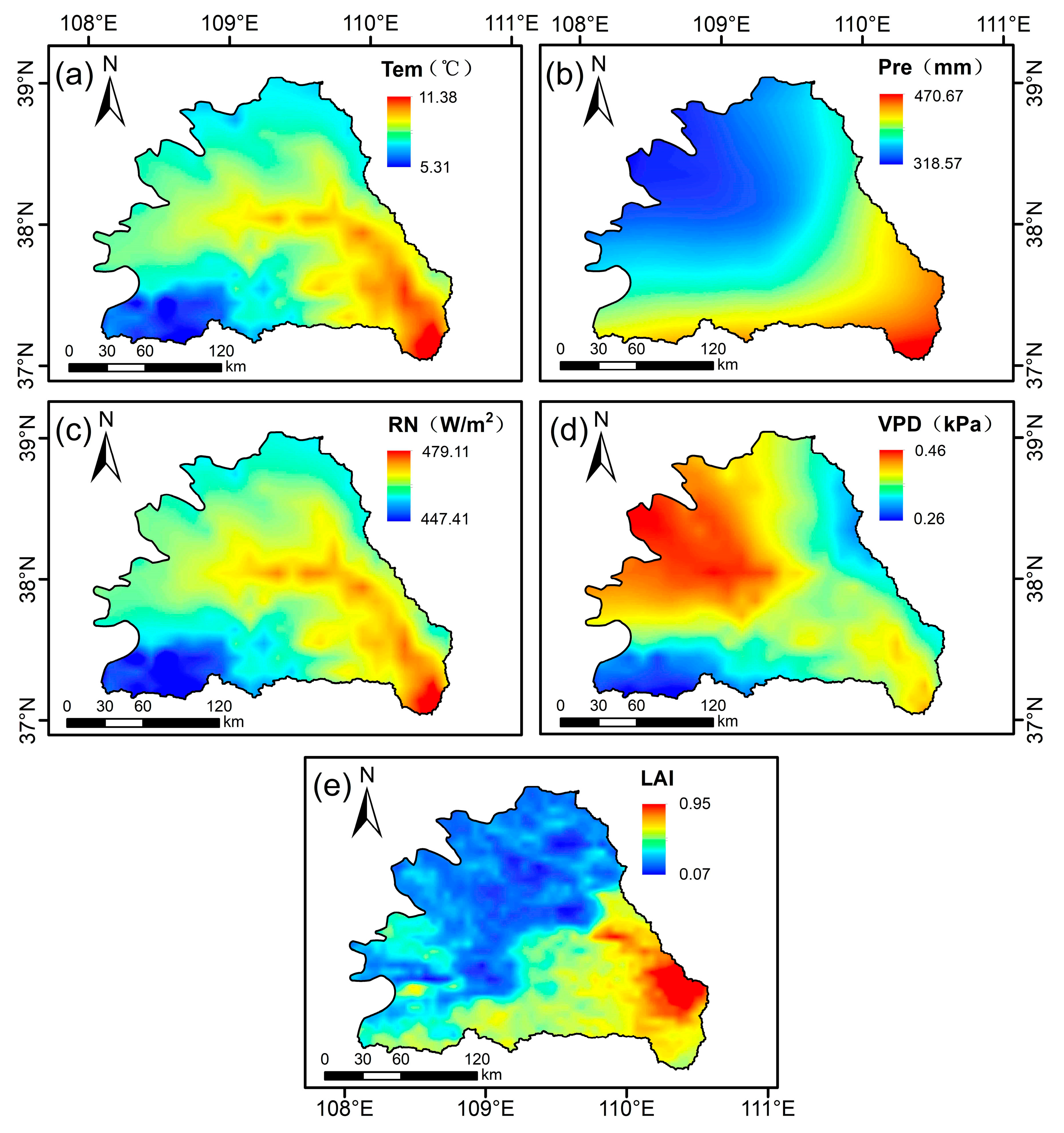

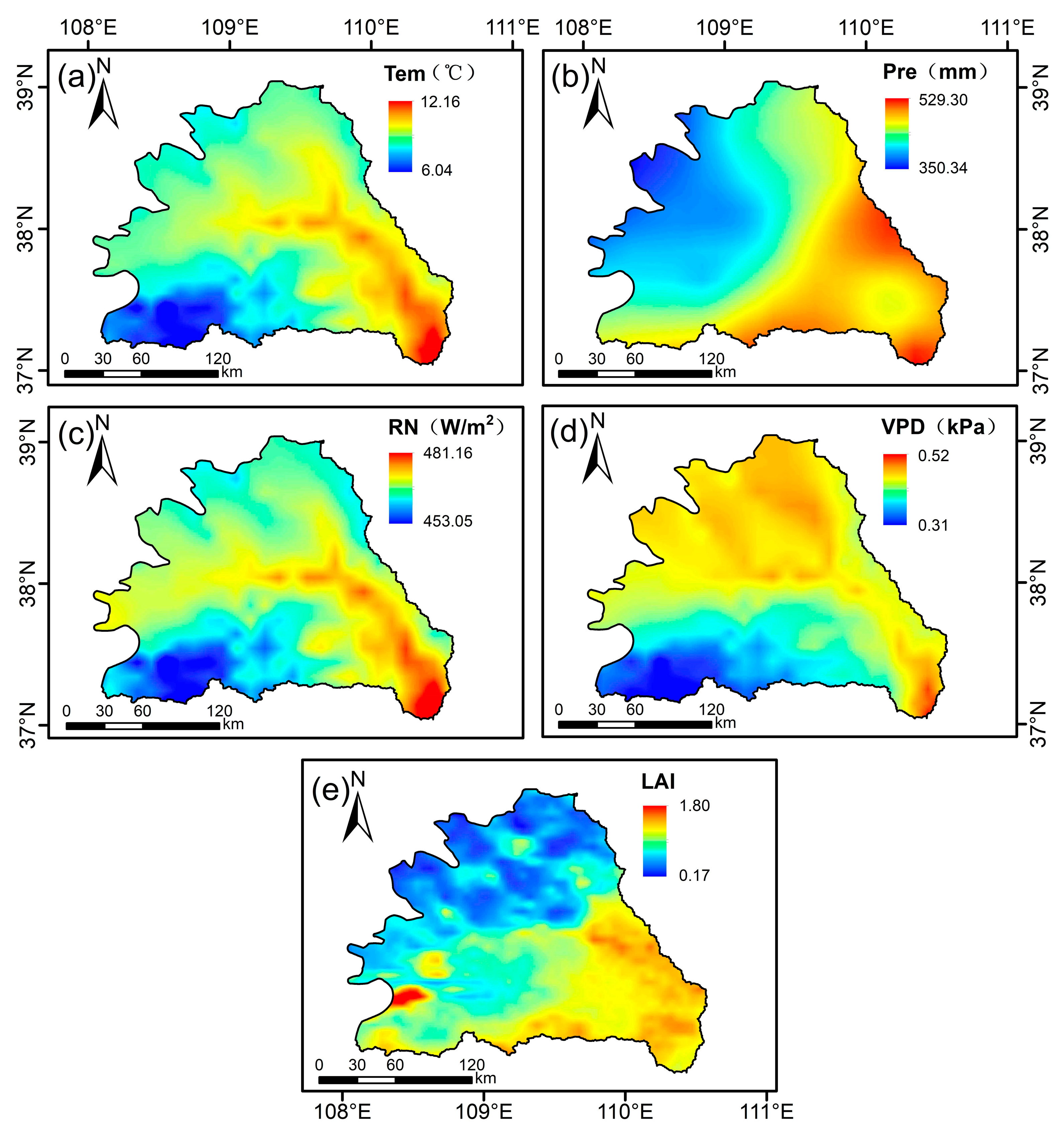
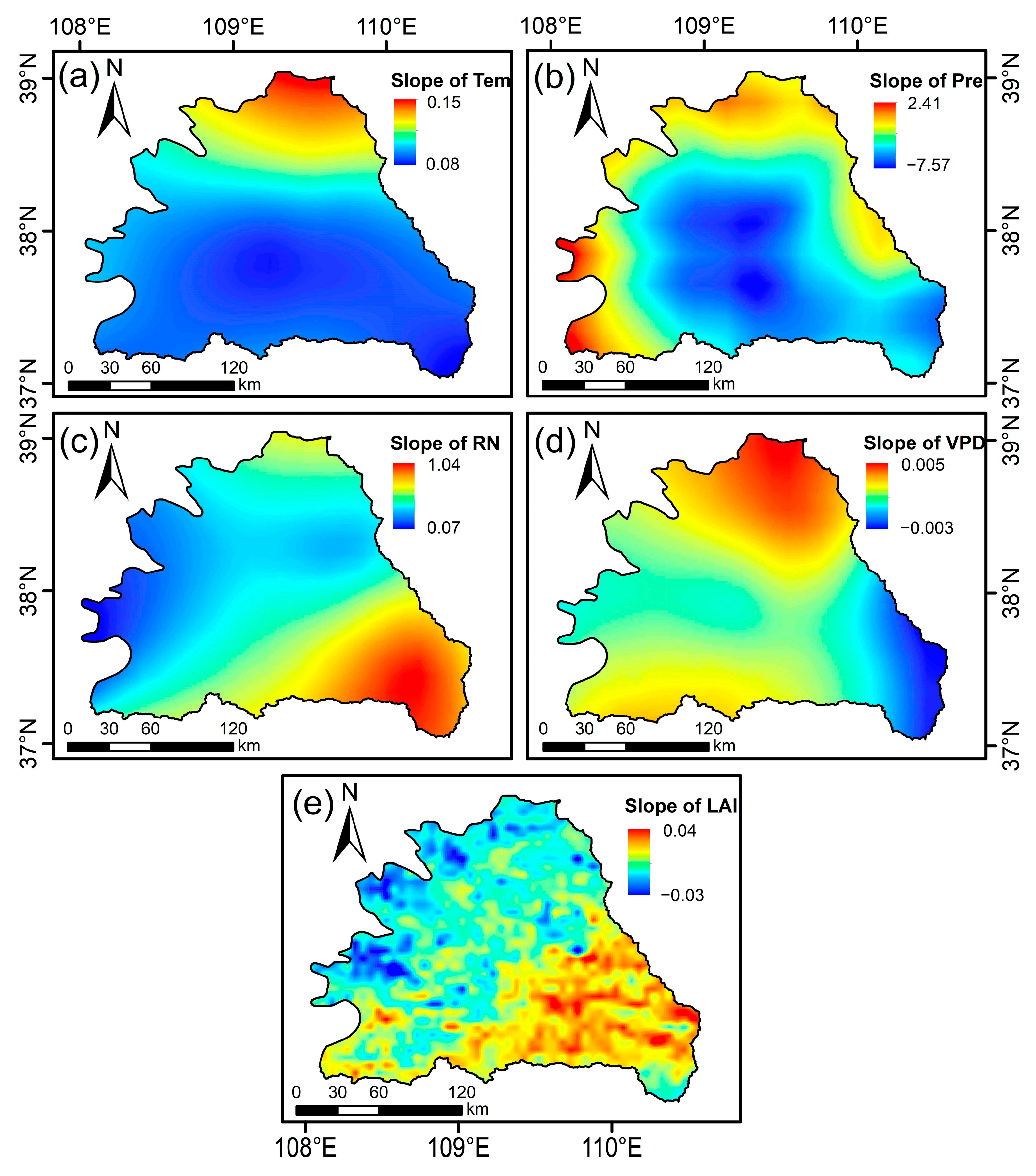
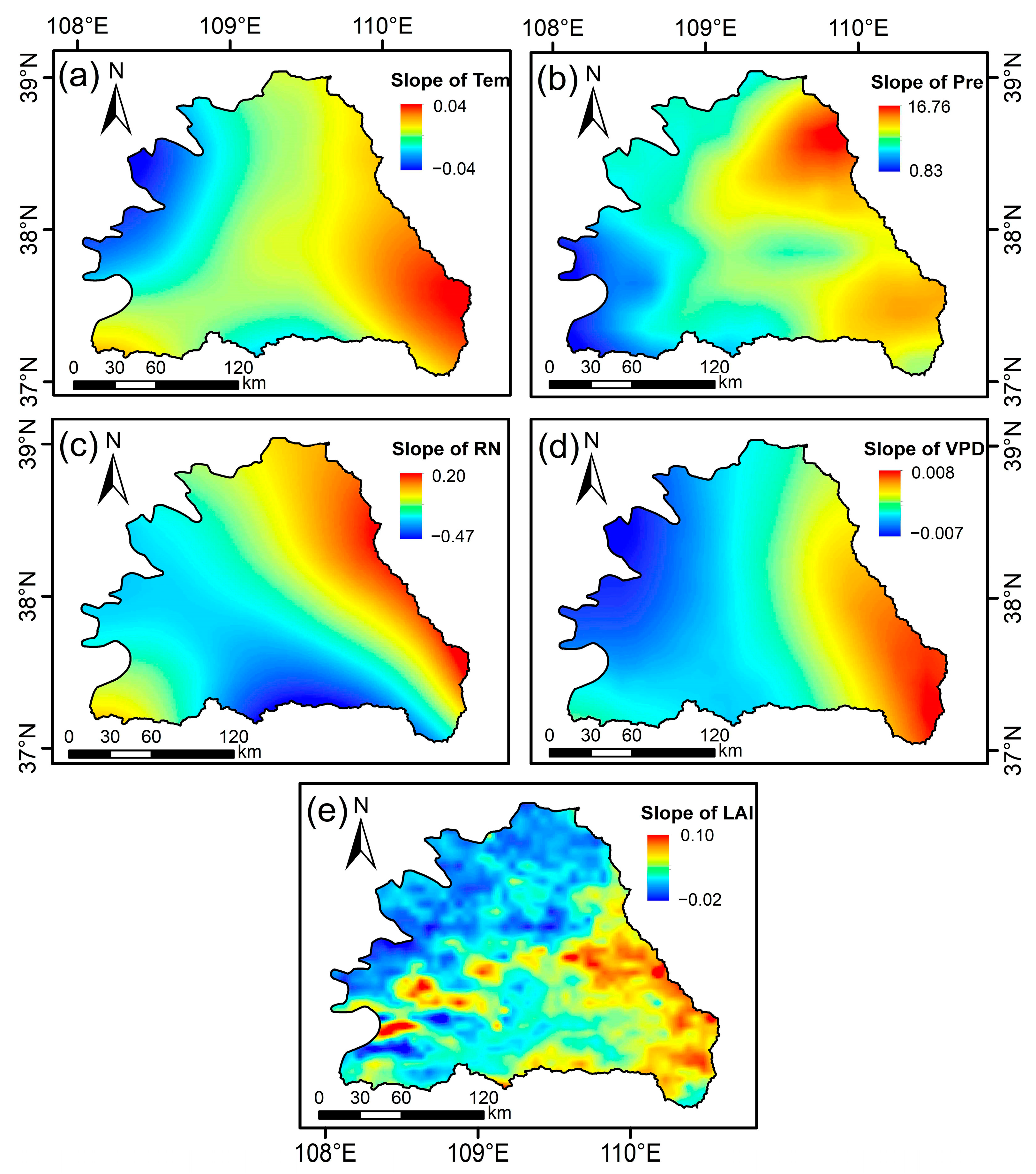
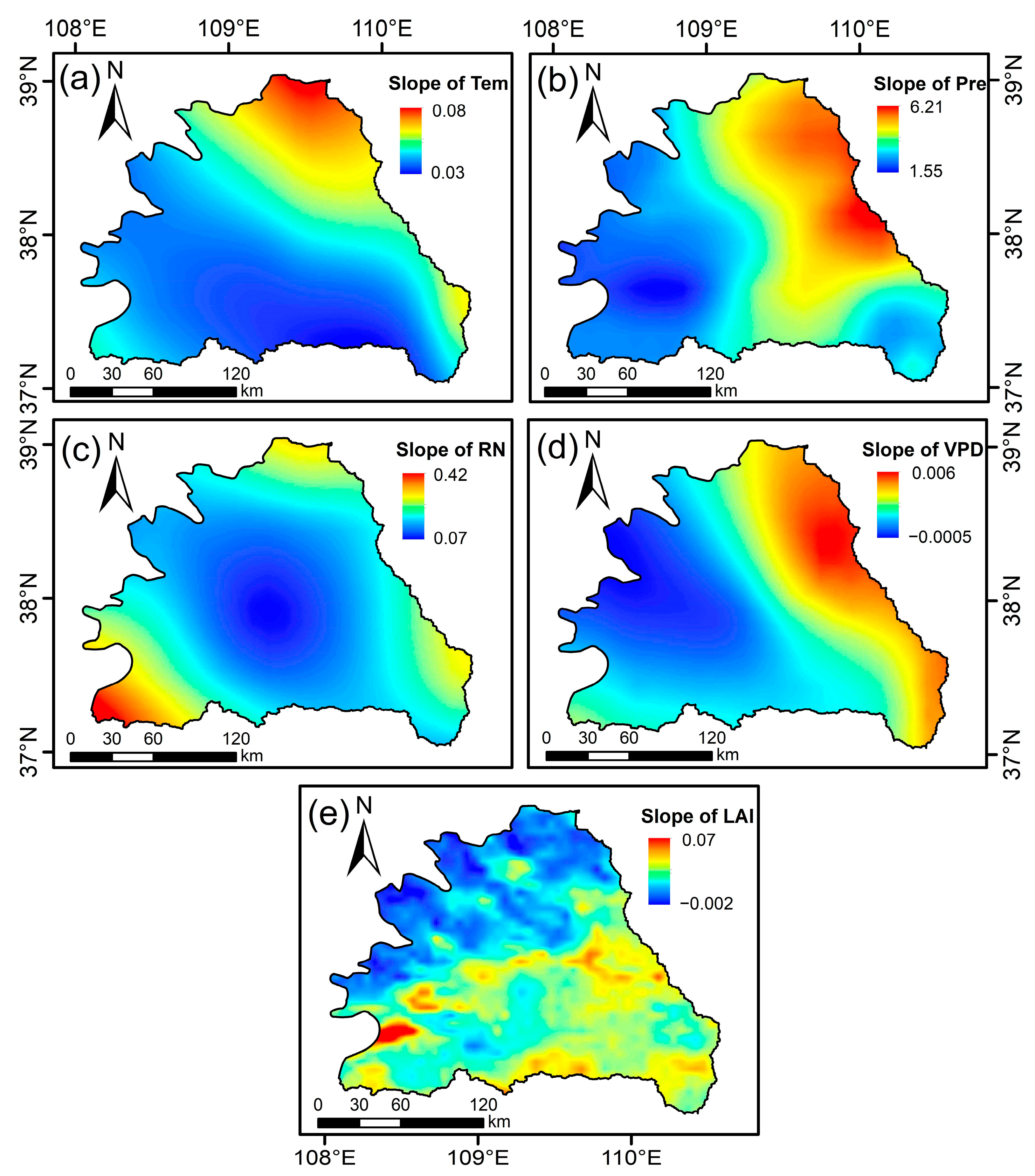
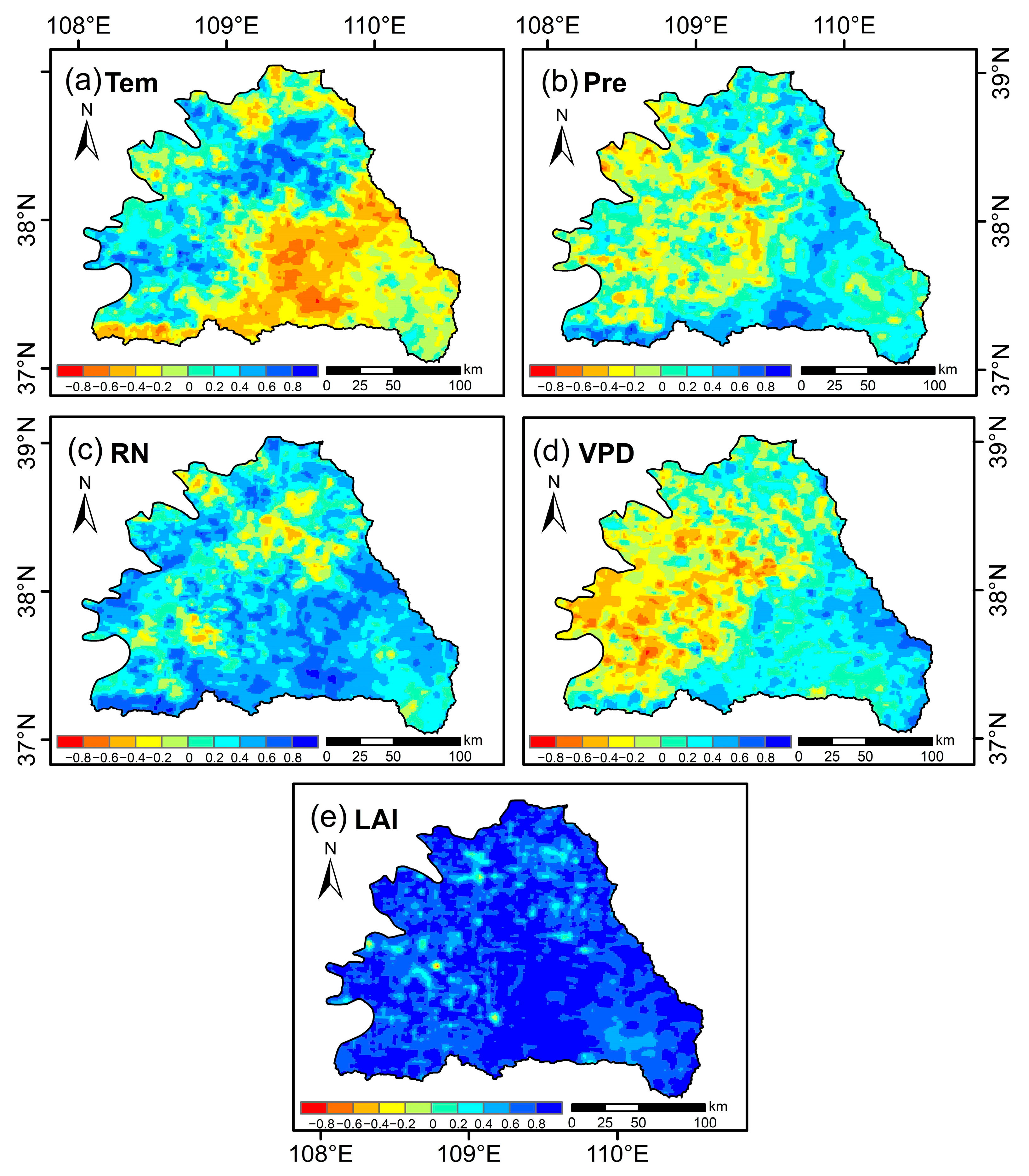
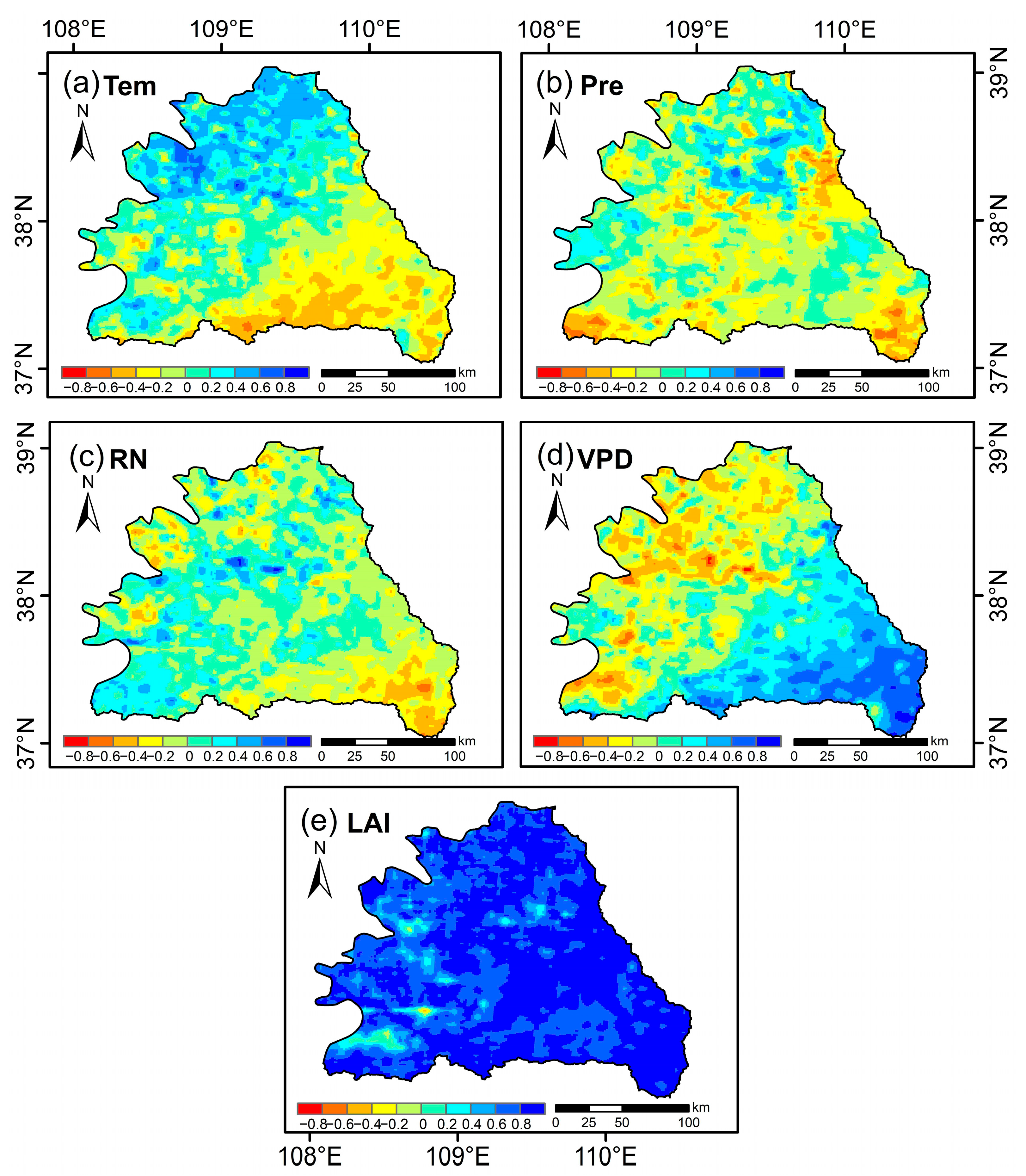
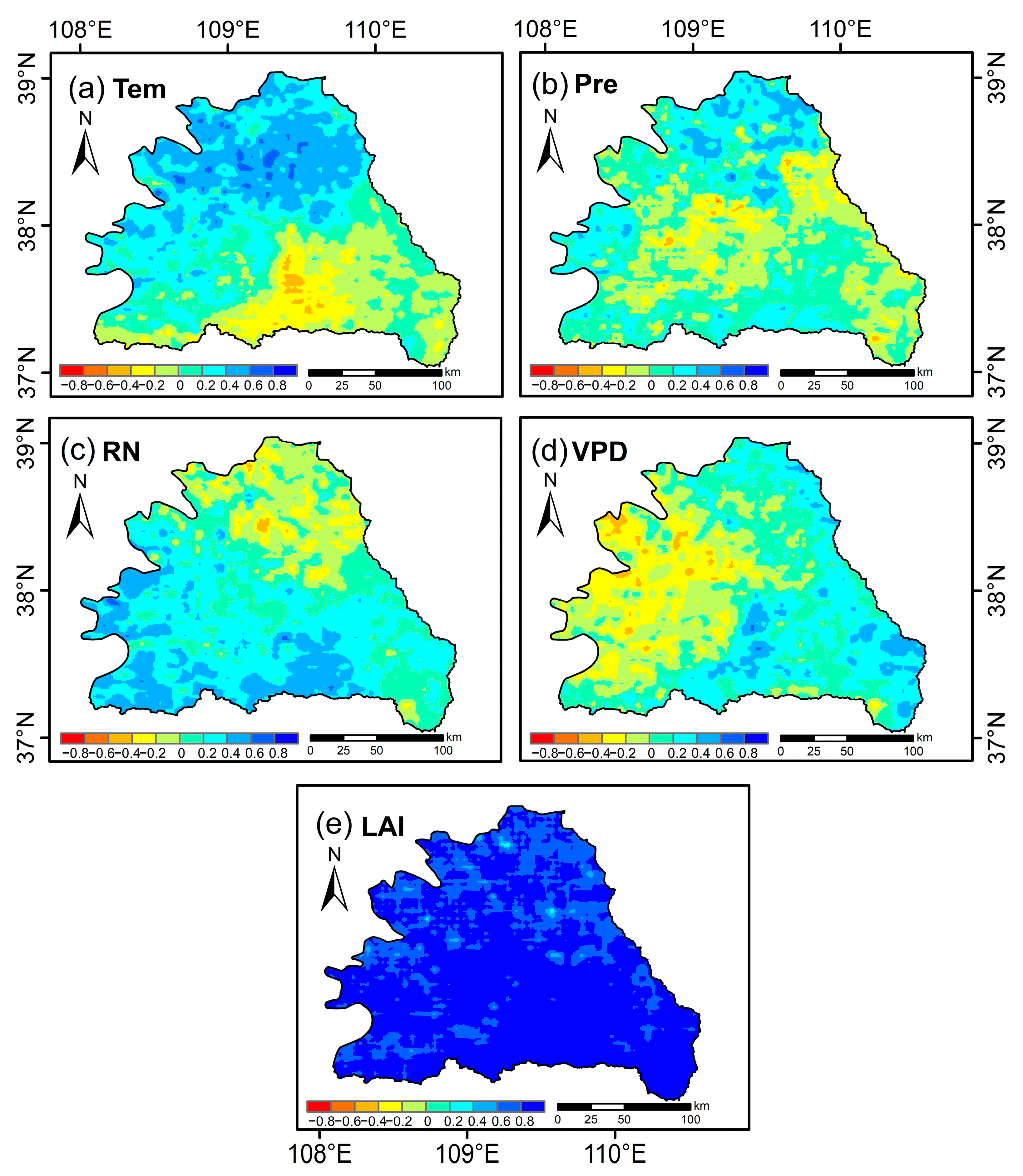
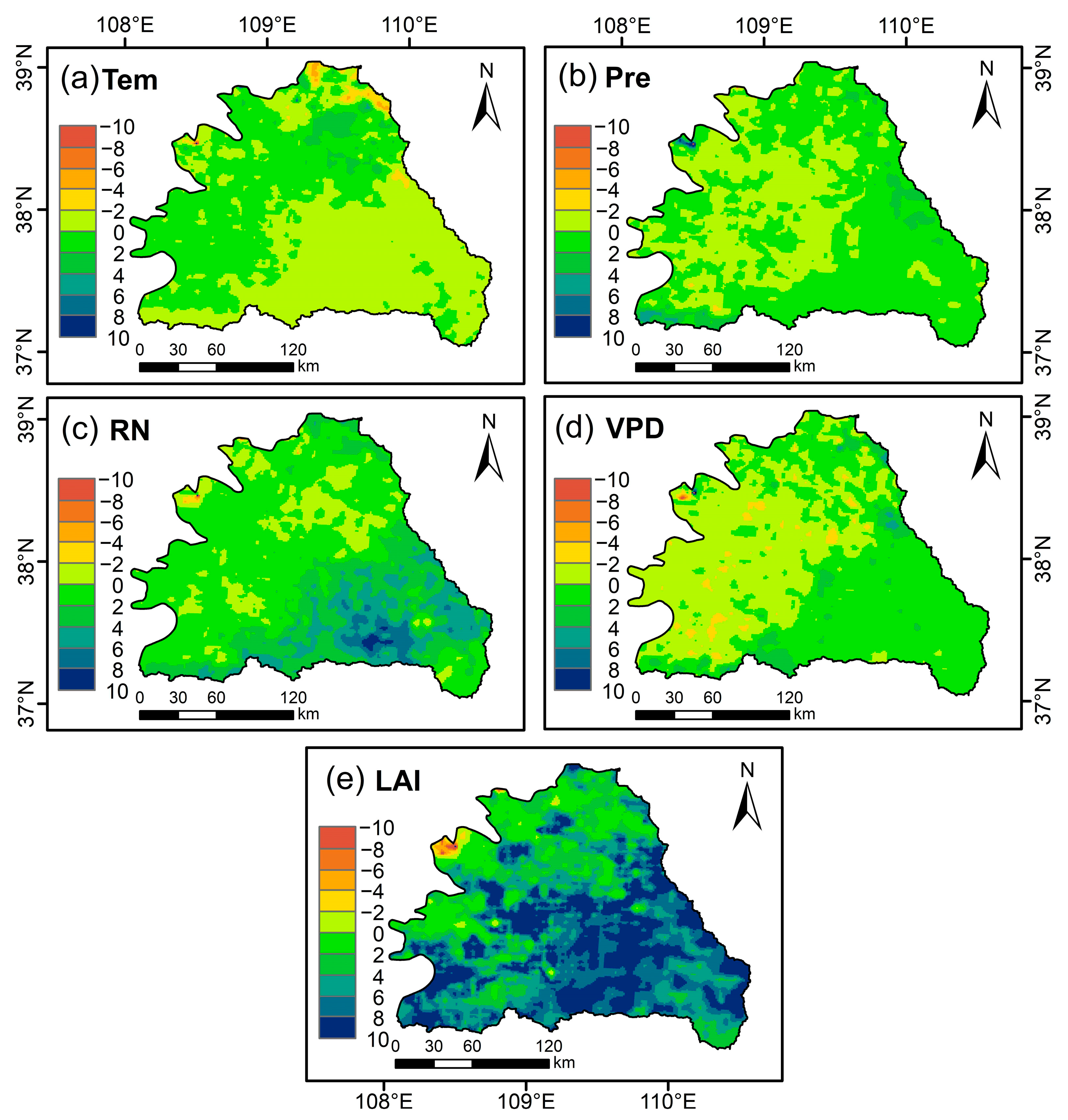
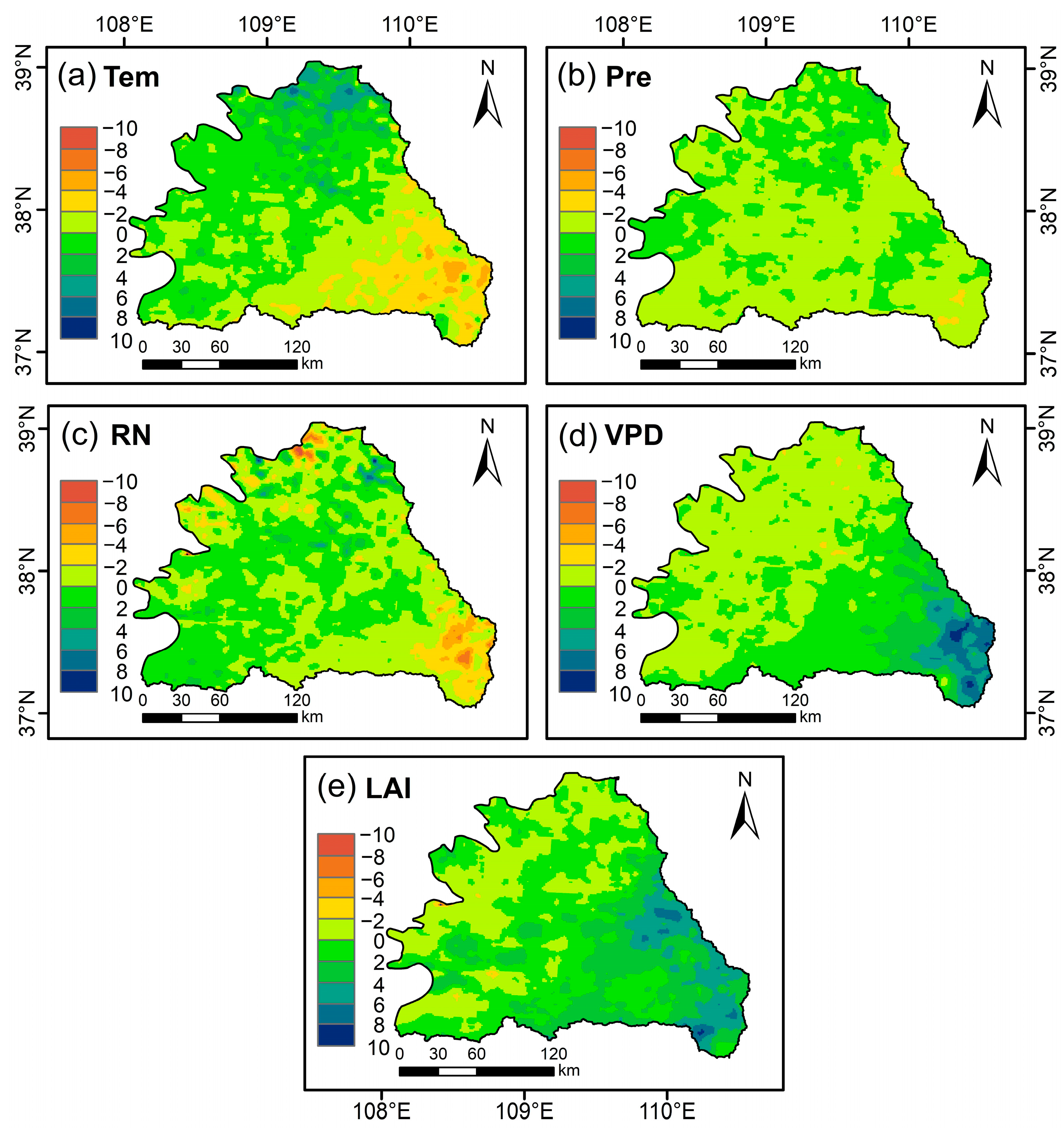


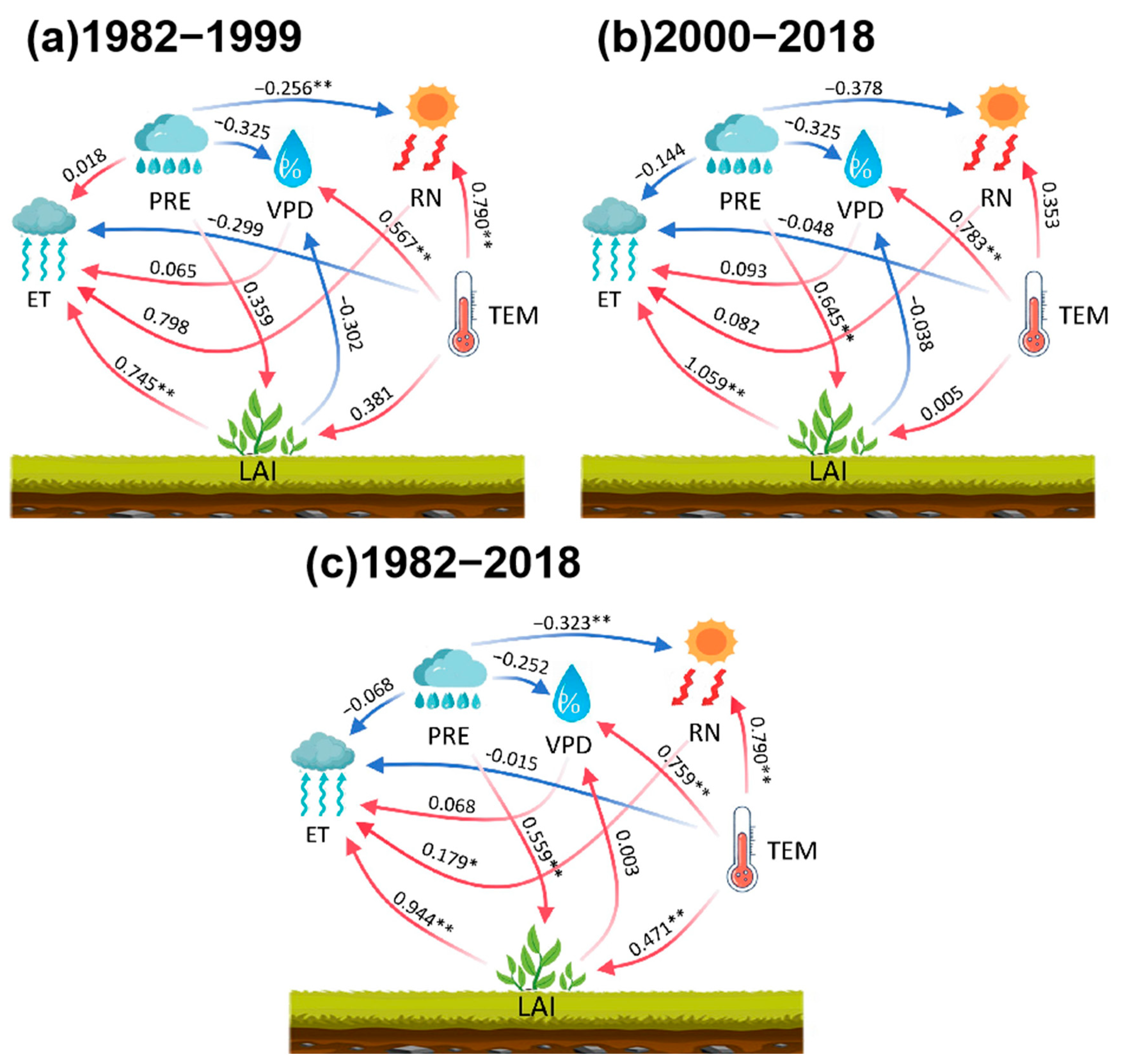
Disclaimer/Publisher’s Note: The statements, opinions and data contained in all publications are solely those of the individual author(s) and contributor(s) and not of MDPI and/or the editor(s). MDPI and/or the editor(s) disclaim responsibility for any injury to people or property resulting from any ideas, methods, instructions or products referred to in the content. |
© 2025 by the authors. Licensee MDPI, Basel, Switzerland. This article is an open access article distributed under the terms and conditions of the Creative Commons Attribution (CC BY) license (https://creativecommons.org/licenses/by/4.0/).
Share and Cite
Zhang, G.; Wang, Z.; Ren, H.; Shen, Q.; Xue, T.; Wang, Z.; Chen, X.; Shi, H.; Han, P.; Liu, Y.; et al. Vegetation Restoration Outpaces Climate Change in Driving Evapotranspiration in the Wuding River Basin. Remote Sens. 2025, 17, 1577. https://doi.org/10.3390/rs17091577
Zhang G, Wang Z, Ren H, Shen Q, Xue T, Wang Z, Chen X, Shi H, Han P, Liu Y, et al. Vegetation Restoration Outpaces Climate Change in Driving Evapotranspiration in the Wuding River Basin. Remote Sensing. 2025; 17(9):1577. https://doi.org/10.3390/rs17091577
Chicago/Turabian StyleZhang, Geyu, Zijun Wang, Hanyu Ren, Qiaotian Shen, Tingyi Xue, Zongsen Wang, Xu Chen, Haijing Shi, Peidong Han, Yangyang Liu, and et al. 2025. "Vegetation Restoration Outpaces Climate Change in Driving Evapotranspiration in the Wuding River Basin" Remote Sensing 17, no. 9: 1577. https://doi.org/10.3390/rs17091577
APA StyleZhang, G., Wang, Z., Ren, H., Shen, Q., Xue, T., Wang, Z., Chen, X., Shi, H., Han, P., Liu, Y., & Wen, Z. (2025). Vegetation Restoration Outpaces Climate Change in Driving Evapotranspiration in the Wuding River Basin. Remote Sensing, 17(9), 1577. https://doi.org/10.3390/rs17091577






